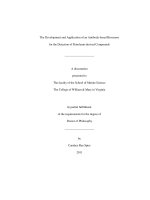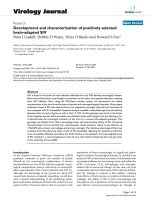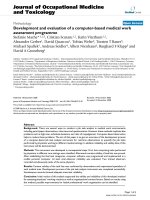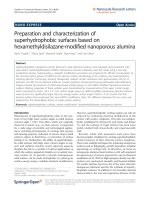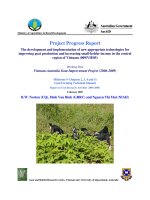Development and characterization of new magnesium based nanocomposites
Bạn đang xem bản rút gọn của tài liệu. Xem và tải ngay bản đầy đủ của tài liệu tại đây (8.8 MB, 210 trang )
DEVELOPMENT AND CHARACTERIZATION OF
NEW MAGNESIUM BASED
NANOCOMPOSITES
KHIN SANDAR TUN
NATIONAL UNIVERSITY OF SINGAPORE
2009
DEVELOPMENT AND CHARACTERIZATION OF
NEW MAGNESIUM BASED
NANOCOMPOSITES
KHIN SANDAR TUN
(B. Eng., YTU, M. Sc., NUS)
A THESIS SUBMITTED
FOR THE DEGREE OF DOCTOR OF PHILOSOPHY
DEPARTMENT OF MECHANICAL ENGINEERING
NATIONAL UNIVERSITY OF SINGAPORE
2009
Preface
Development and Characterization of New Magnesium Based Nanocomposites
i
PREFACE
This thesis is submitted for the degree of Doctor of Philosophy in the
Department of Mechanical Engineering at the National University of Singapore. The
research herein was carried out under the supervision of Associate Professor Manoj
Gupta from the Materials Science Division. To the best of my knowledge, this work is
original except references which are made to previous work. Neither similar thesis nor
any part of this thesis has been or is being submitted for any degrees or other
qualification at any other university or Institution. Part of this thesis has been published
in international journals. This thesis contains no more than 40,000 words.
Acknowledgements
Development and Characterization of New Magnesium Based Nanocomposites
ii
ACKNOWLEDGEMENTS
First and foremost, I wish to express my sincere gratitude to my supervisor,
Associate Professor Manoj Gupta for his encouragement, support and valuable
guidance. This work could not have been completed without his understanding,
patience, motivation, enthusiasm, immense knowledge and especially his continuous
support. I could not have imagined having a better advisor for my Ph.D study. I am
proud to have an opportunity to carry out my research study under his supervision.
I would also like to express my warm thanks to Mr. Thomas Tan Bah Chee,
Mr. Abdul Khalim Bin Abdul, Mr. Juraimi Bin Madon, Mr. Ng Hong Wei, Mr. Maung
Aye Thein and Mrs. Zhong Xiang Li from the Materials Science Laboratory for their
assistance throughout my study in NUS. Special thanks to Mr. Lam Kim Song from
Fabrication Support Center (FSC), NUS for his cordial help in preparation of materials
using CNC Lathe machine.
My most sincere thanks also go to my colleagues, my fellow labmates and my
seniors, especially Dr. Wong Wei Leong, Eugene for their guidance, understanding
and kind support. My deep sense of gratitude also goes to my close friend and labmate,
Mr. Myo Minn who always offers me encouragement and full-hearted help during the
entire length of my study.
My heartfelt thanks go to my family, especially my parents for supporting me
with earnest love throughout my life. I owe my warmest gratitude to my elder brother,
Mr. Tun Mon Oo for his valuable assistance to make this study possible.
Table of Contents
Development and Characterization of New Magnesium Based Nanocomposites
iii
TABLE OF CONTENTS
PREFACE
i
ACKNOWLEDGEMENTS
ii
TABLE OF CONTENTS
iii
SUMMARY
x
LIST OF TABLES
xiii
LIST OF FIGURES
xiv
PUBLICATIONS
xviii
CHAPTER 1 INTRODUCTION
1.1 Overview 1
1.2 Organization of Thesis 5
1.3 References 8
CHAPTER 2 LITERATURE REVIEW
2.1 Introduction 11
2.2 Different Types of Metal Matrix Composites (MMCs) 14
2.2.1 Aluminum Matrix Composites (Al-MMCs) 14
2.2.2 Titanium Matrix Composites (Ti-MMCs) 15
2.2.3 Magnesium Matrix Composites (Mg-MMCs) 16
2.3 Production Methods for Mg-MMCs 18
2.3.1 Liquid Phase Processes 19
2.3.1.1 Stir Casting 19
2.3.1.2 Squeeze Casting 20
2.3.2 Solid Phase Processes 21
2.3.2.1 Mechanical Alloying (MA) 21
2.3.2.2 Powder Metallurgy (PM) 22
Table of Contents
Development and Characterization of New Magnesium Based Nanocomposites
iv
2.4 Microwave Processing of Materials 23
2.4.1 Background on Microwave Heating 23
2.4.2 Microwave Sintering of Materials 25
2.5 Motivation of Current Work 26
2.6 References
28
CHAPTER 3
MATERIALS AND EXPERIMENTAL
METHODOLOGIES
3.1 Overview 33
3.2 Materials 33
3.3 Primary Processing 34
3.4 Secondary Processing 35
3.4.1 Extrusion 35
3.5 Density Measurements 36
3.6 Microstructural Characterization 36
3.7 X-Ray Diffraction Studies 37
3.8 Coefficient of Thermal Expansion 37
3.9 Mechanical Characterization 38
3.9.1 Microhardness 38
3.9.2 Tensile Testing 38
3.9.3 Compression Testing 38
3.10 Fractography 39
3.11 References 39
CHAPTER 4 DEVELOPMENT OF Mg/Y
2
O
3
NANOCOMPOSITES
Summary 40
4.1 Introduction 40
4.2 Results 42
Table of Contents
Development and Characterization of New Magnesium Based Nanocomposites
v
4.2.1 Macrostructure 42
4.2.2 Density Measurements 42
4.2.3 Microstructural Characterization 42
4.2.4 X-Ray Diffraction Studies 44
4.2.5 Coefficient of Thermal Expansion 45
4.2.6 Mechanical Behavior 46
4.2.7 Fractography 47
4.3 Discussion 48
4.3.1 Synthesis of Mg and Mg/Y
2
O
3
Nanocomposites 48
4.3.2 Microstructure 49
4.3.3 Coefficient of Thermal Expansion 50
4.3.4 Mechanical Behavior 50
4.3.5 Fracture Behavior 54
4.4 Conclusions 54
4.5 References
55
CHAPTER 5
EFFECT OF HEATING RATE ON Mg AND Mg/Y
2
O
3
NANOCOMPOSITE DURING HYBRID MICROWAVE
SINTERING
Summary 58
5.1 Introduction 58
5.2 Results 60
5.2.1 Macrostructure 60
5.2.2 Density Measurements 60
5.2.3 Microstructural Characterization 61
5.2.4 Mechanical Behavior 63
5.2.5 Fractography 64
Table of Contents
Development and Characterization of New Magnesium Based Nanocomposites
vi
5.3 Discussion 65
5.3.1 Densification Behavior 65
5.3.2 Microstructural Observations 66
5.3.3 Mechanical Behavior 67
5.3.4 Fracture Behavior 68
5.4 Conclusions 69
5.5 References
69
CHAPTER 6
EFFECT OF EXTRUSION RATIO ON MICROWAVE
SINTERED Mg AND Mg/Y
2
O
3
NANOCOMPOSITE
Summary 72
6.1 Introduction 72
6.2 Results 73
6.2.1 Macrostructure 73
6.2.2 Density Measurements 74
6.2.3 Microstructural Characterization 75
6.2.4 Mechanical Behavior 77
6.2.5 Fractography 78
6.3 Discussion 80
6.3.1 Densification Behavior 80
6.3.2 Microstructural Evolution 81
6.3.3 Mechanical Behavior 83
6.3.4 Fractography 87
6.4 Conclusions 88
6.5 References
88
Table of Contents
Development and Characterization of New Magnesium Based Nanocomposites
vii
CHAPTER 7
DEVELOPMENT OF Mg/(Y
2
O
3
+Cu) HYBRID
NANOCOMPOSITES
Summary 92
7.1 Introduction 93
7.2 Results and Discussion 94
7.2.1 Macrostructure 94
7.2.2 Density and Porosity Measurements 95
7.2.3 Initial Microstructure 96
7.2.3.1 Characterization of Grains 96
7.2.3.2 Distribution of Reinforcement 99
7.2.4 Tensile Behavior 101
7.2.5 Fractography 106
7.3 Conclusions 109
7.4 References
110
CHAPTER 8
DEVELOPMENT OF Mg/(Y
2
O
3
+Ni) HYBRID
NANOCOMPOSITES
Summary 113
8.1 Introduction 113
8.2 Results 115
8.2.1 Macrostructure 115
8.2.2 Density and Porosity 115
8.2.3 Microstructure 116
8.2.4 X-Ray Diffraction Studies 118
8.2.5 Microhardness 119
8.2.6 Tensile Properties 119
8.2.7 Tensile Failure Analysis 121
Table of Contents
Development and Characterization of New Magnesium Based Nanocomposites
viii
8.3 Discussion 121
8.3.1 Synthesis of Materials 121
8.3.2 Microstructural Analysis 122
8.3.3 Mechanical Behavior 125
8.3.3.1 Microhardness 125
8.3.3.2 Tensile Properties 125
8.3.4 Tensile Failure Behavior 127
8.4 Conclusions 128
8.5 References
129
CHAPTER 9
COMPRESSIVE PROPERTIES AND DEFORMATION
BEHAVIOR OF MAGNESIUM HYBRID
NANOCOMPOSITES
Summary 132
9.1 Introduction 132
9.2 Mg/(Y
2
O
3
+Cu) Hybrid Nanocomposites 134
9.2.1 Results 134
9.2.1.1 Density and Porosity Measurements 134
9.2.1.2 Microstructure 134
9.2.1.3 X-Ray Diffraction Studies 136
9.2.1.4 Microhardness 139
9.2.1.5 Compressive Flow Behavior 139
9.2.1.6 Compressive Properties 140
9.2.1.7 Fractography 141
9.2.2 Discussion 142
9.2.2.1 Orientation of Crystal Planes 142
9.2.2.2 Microhardness 143
Table of Contents
Development and Characterization of New Magnesium Based Nanocomposites
ix
9.2.2.3 Compressive Deformation
143
9.2.2.4 Compressive Failure Analysis 150
9.3 Mg/(Y
2
O
3
+Ni) Hybrid Nanocomposites
151
9.3.1 Results
151
9.3.1.1 Density and Grain Size
Measurements
151
9.3.1.2 Twinning Behavior
152
9.3.1.3 XRD Analysis and Crystal
Orientation
155
9.3.1.4 Flow Curves
157
9.3.1.5 Compressive Properties
158
9.3.1.6 Fractography
159
9.3.2 Discussion
160
9.3.2.1 Orientation of Crystal Planes
160
9.3.2.2 Strengthening Effect of Secondary
Phases
161
9.3.2.3 Compressive Deformation
Mechanisms
162
9.4 Conclusions
166
9.5 References
167
CHAPTER 10
GENERAL CONCLUSIONS
171
CHAPTER 11
RECOMMENDATIONS
175
APPENDIX A
177
Summary
Development and Characterization of New Magnesium Based Nanocomposites
x
SUMMARY
In the present work, Mg/Ceramic nanocomposites and Mg/(Ceramic+Metal)
hybrid nanocomposites were developed using microwave assisted powder metallurgy
route. The current research project can be divided into three sections: (1) development
of Mg/Y
2
O
3
nanocomposites via powder metallurgy route involving innovative hybrid
microwave sintering approach followed by hot extrusion, (2) optimization of primary
processing parameter (heating rate during hybrid microwave sintering) and secondary
processing parameter (extrusion ratio during hot extrusion) and (3) development of
magnesium based hybrid nanocomposites containing ceramic and metal
nanoparticulate reinforcements.
Mg/Y
2
O
3
nanocomposites were developed using microwave assisted powder
metallurgy route. Two different compositions of Mg/Y
2
O
3
nanocomposites,
Mg/0.17vol.%Y
2
O
3
and Mg/0.7vol.%Y
2
O
3
, were critically investigated. Between two
compositions, Mg/0.7vol.%Y
2
O
3
exhibited the best strength and ductility combination.
Since microwave sintering is a newly developed method for synthesis of
metallic composites, an investigation into the effect of heating rate on pure Mg and
optimized nanocomposite composition of Mg/0.7vol.%Y
2
O
3
during hybrid microwave
sintering was carried out. Two different heating rates, 49°C/min and 20°C/min, were
used for the synthesis of materials. Best combination of overall mechanical properties
was attained from the nanocomposite synthesized using high heating rate (49°C/min).
High heating rate was thus chosen for synthesis of further composite systems. To find
the effective extrusion ratio, microwave sintered Mg and Mg/0.7vol.%Y
2
O
3
nanocomposite with high heating rate were extruded using three different extrusion
Summary
Development and Characterization of New Magnesium Based Nanocomposites
xi
ratios (12:1, 19:1 and 25:1). 25:1 was seen as the best extrusion ratio as it provides the
best combination of mechanical properties.
Aiming to further enhance the properties of Mg/0.7vol.%Y
2
O
3
and to establish
the effectiveness of hybrid microwave sintering approach, two hybrid nanocomposite
systems, Mg/(Y
2
O
3
+Cu) and Mg/(Y
2
O
3
+Ni) were developed.
For synthesis of Mg/(Y
2
O
3
+Cu) hybrid nanocomposites, three different volume
percentages of Cu (0.3, 0.6 and 1.0) were added as hybrid reinforcements into
Mg/0.7vol.%Y
2
O
3
composition. As compared to Mg/0.7Y
2
O
3
nanocomposite, a
significant reduction in grain size was observed in Mg/(Y
2
O
3
+Cu) hybrid
nanocomposites realizing the efficient use of metal nanoparticulates as hybrid
reinforcement. The resultant grain refinement and good distribution of secondary
phases led to an achievement in higher tensile strengths (0.2%YS and UTS) and
ductility in Mg/(0.7Y
2
O
3
+0.3Cu) hybrid nanocomposite composition over
Mg/0.7Y
2
O
3
nanocomposite. From microhardness and compression tests, the best
microhardness and significant improvement in 0.2%CYS and UCS with a compromise
in ductility was observed in Mg/(0.7Y
2
O
3
+1.0Cu) hybrid nanocomposite.
The same variation in volume percentages of Ni nanoparticulate reinforcements
as in Mg/(Y
2
O
3
+Cu) hybrid nanocomposites was chosen for the preparation of
Mg/(Y
2
O
3
+Ni) hybrid nanocomposite systems to investigate the effect of type of metal
reinforcements on microstructure and mechanical properties. Similar trend of grain
refinement and good distribution of secondary phases was observed in Mg/(Y
2
O
3
+Ni)
hybrid nanocomposite system as that in Mg/(Y
2
O
3
+Cu) hybrid nanocomposite system.
The best microhardness was exhibited by Mg/(0.7Y
2
O
3
+1.0Ni) hybrid nanocomposite.
Best combination of tensile strengths and ductility was exhibited by
Summary
Development and Characterization of New Magnesium Based Nanocomposites
xii
Mg/(0.7Y
2
O
3
+0.6Ni) hybrid nanocomposite. Compression testing results revealed a
significant improvement in both 0.2%CYS and UCS in the case of Mg/(Y
2
O
3
+Ni)
hybrid nanocomposites over pure magnesium while the ductility was adversely
affected.
List of Tables
Development and Characterization of New Magnesium Based Nanocomposites
xiii
LIST OF TABLES
Table 2.1
Advantages and disadvantages of fiber MMCs compared to PMCs.
13
Table 2.2
Mechanical properties of various Mg based materials.
18
Table 4.1
Results of density, porosity and grain morphology determinations.
43
Table 4.2
Results of CTE and microhardness measurements.
45
Table 4.3
Results of ambient temperature tensile properties.
46
Table 5.1
Results of density, porosity and pore and grain morphologies.
61
Table 5.2
Results of microhardness and room temperature tensile properties.
64
Table 6.1
Results of grain morphology determinations.
75
Table 7.1
Results of density, porosity and grain morphology determinations.
96
Table 7.2
Results of room temperature tensile properties.
102
Table 8.1
Results of density, porosity and grain morphology determinations.
115
Table 8.2
Results of microhardness and room temperature tensile properties.
119
Table 9.1
Results of density, porosity and grain size measurements.
134
Table 9.2
Results of grain size, microhardness and room temperature
compressive properties of Mg and Mg nanocomposites.
139
Table 9.3
Results of density and grain morphology determinations.
152
Table 9.4
Results of room temperature compressive properties of Mg and Mg
nanocomposites.
159
List of Figures
Development and Characterization of New Magnesium Based Nanocomposites
xiv
LIST OF FIGURES
Figure 3.1
Schematic diagram of experimental setup.
35
Figure 4.1
Representative FESEM micrographs showing reinforcement
distribution of Y
2
O
3
particulates and presence of nanopores in the
case of: (a) Mg/0.17Y
2
O
3
and (b) Mg/0.7Y
2
O
3
.
43
Figure 4.2
EDS analysis showing the presence of Y
2
O
3
particulates in the
case of: (a) Mg/0.17Y
2
O
3
and (b) Mg/0.7Y
2
O
3
.
44
Figure 4.3
X-Ray diffractograms of Mg and Mg/Y
2
O
3
samples.
45
Figure 4.4
Representative stress-strain curves of pure Mg and Mg/Y
2
O
3
nanocomposites.
47
Figure 4.5
Representative fractrographs showing: (a) brittle failure in pure
Mg, (b) intergranular
crack propagation in the case of
Mg/0.17%Y
2
O
3
and (c) some dimple like features in the case of
Mg/0.7%Y
2
O
3
.
48
Figure 5.1
Representative micrographs showing grain morphology of: (a)
pure Mg and (b) Mg/Y
2
O
3
sintered at low heating rate.
62
Figure 5.2
Representative FESEM micrographs showing: (a) particulate
distribution and (b) presence of minimal pores in Mg/Y
2
O
3
sample sintered at high heating rate, and (c) particulate clusters
and agglomerates and (d) presence of micron pores in Mg/Y
2
O
3
sample sintered at low heating rate.
63
Figure 5.3
Representative fractographs showing: (a) fracture surface of Mg
sintered at high heating rate, (b) fracture surface of Mg sintered at
low heating rate, (c) intergranular fracture in Mg/Y
2
O
3
sintered at
high heating rate and (c) ductile cleavage in Mg/Y
2
O
3
sintered at
low heating rate.
65
Figure 6.1
Effect of extrusion ratio on: (a) density and (b) porosity.
74
Figure 6.2
Optical micrographs showing grain morphology of pure
magnesium and magnesium nanocomposites extruded at different
extrusion ratios.
76
List of Figures
Development and Characterization of New Magnesium Based Nanocomposites
xv
Figure 6.3
FESEM micrographs showing particle distribution in Mg/Y
2
O
3
nanocomposites extruded at extrusion ratio of: (a) 12:1, (b) 19:1
and (c) 25:1.
77
Figure 6.4 Effect of extrusion ratio on microhardness.
78
Figure 6.5
Effect of extrusion ratio on: (a) 0.2% yield strength, (b) ultimate
tensile strength and (c) failure strain.
79
Figure 6.6
Representative tensile fracture surfaces of pure magnesium and
magnesiu
m nanocomposites extruded at different extrusion
ratios.
80
Figure 6.7
Grain size distribution at different extrusion ratio for: (a) pure
magnesium samples, (b) magnesium nanocomposite samples,
and grain size distribution for pure magnesium and magnesium
nanocomposite at extrusion ratio of: (c) 12:1, (d) 19:1 and (e)
25:1.
82
Figure 6.8
Relationship between microhardness and yield strength for: (a)
Mg and (b) Mg/Y
2
O
3
nanocomposite, and microhardness and
ultimate tensile strength for: (c) Mg and (d) Mg/Y
2
O
3
nanocomposite at different extrusion ratios.
86
Figure 7.1
Representative micrographs showing the presence of: (a)
intermetallics using EDS analysis, (b) yttria particulates and (c)
intermetallics at grain boundary in Mg/(0.7Y
2
O
3
+0.3Cu) hybrid
nanocomposite.
98
Figure 7.2
Representative micrographs showing: (a) continual network of
copper agglomerates along the grain boundary and (b) copper
clusters/agglomerates at grain interior in Mg/(0.7Y
2
O
3
+0.3Cu)
hybrid nanocomposite.
99
Figure 7.3
Representative micrographs showing: (a) coexistence of yttria
and copper, (b) the distribution of intermetallics in
Mg/(0.7Y
2
O
3
+0.3Cu) hybrid nanocomposite, (c) presence of
copper clusters and coarse copper agglomerate, (d) the
distribution of intermetallics in Mg/(0.7Y
2
O
3
+0.6Cu) hybrid
nanocomposites and (e) the distribution of yttria in Mg/0.7Y
2
O
3
nanocomposite.
100
List of Figures
Development and Characterization of New Magnesium Based Nanocomposites
xvi
Figure 9.2
FESEM micrographs showing distribution of second phases in:
(a) Mg/(0.7Y
2
O
3
+0.3Cu), (b) Mg/(0.7Y
2
O
3
+0.6Cu) and (c)
Mg/(0.7Y
2
O
3
+1.0Cu) hybrid nanocomposites.
136
Figure 7.4
Representative fractographs showing: (a) brittle failure in Mg, (b)
brittle-ductile mix-mode failure in Mg/Yttria nanocomposite, (c)
ductile failure in Mg/(0.7Y
2
O
3
+0.3Cu) hybrid nanocomposite.
107
Figure 7.5
Representative fractographs showing: (a) the activation of basal
and non-basal slips and (b) the planar and wavy slip patterns in
Mg/(0.7Y
2
O
3
+0.3Cu).
108
Figure 8.1
Representative FESEM micrographs showing distribution of: (a)
yttria particulates in Mg/Y
2
O
3
nanocomposite, and reinforcement
(yttria+nickel) and intermetallic phases in (b)
Mg/(0.7Y
2
O
3
+0.3Ni), (c) Mg/(0.7Y
2
O
3
+0.6Ni)
and (d)
Mg/(0.7Y
2
O
3
+1.0Ni) hybrid nanocomposites.
116
Figure 8.2
Micrographs showing the presence of nickel, yttria and Mg
2
Ni
intermetallics in Mg matrix (a) by using EDS analyses and (b) at
high magnification, and (c) interfacial integrity between Mg
2
Ni
phase and Mg matrix in Mg/(0.7Y
2
O
3
+0.6Ni) hybrid
nanocomposite.
117
Figure 8.3
XRD patterns of Mg, Mg/Y
2
O
3
nanocomposite and
Mg/(Y
2
O
3
+Ni) hybrid nanocomposites.
118
Figure 8.4
SEM fractographs showing: (a) cleavage failure in pure Mg, (b)
localized dimple like structure in Mg/0.7Y
2
O
3
, refined
microstruc
ture with dimple like features in (c)
Mg/(0.7Y
2
O
3
+0.3Ni) and (d) Mg/(0.7Y
2
O
3
+0.6Ni), and with
predominant crack formations (marked by arrows) (e) and
cracking of Mg
2
Ni intermetallic (f) in Mg/(0.7Y
2
O
3
+1.0Ni).
120
Figure 9.1
Representative micrographs showing: (a) twin formation in Mg,
and absence of twinning in (b) Mg/(0.7Y
2
O
3
+0.3Cu), (c)
Mg/(0.7Y
2
O
3
+0.6Cu) and (d) Mg/(0.7Y
2
O
3
+1.0Cu) hybrid
nanocomposites after compression.
135
List of Figures
Development and Characterization of New Magnesium Based Nanocomposites
xvii
Figure 9.3
X-ray diffractograms of Mg, and Mg/(Y
2
O
3
+Cu) hybrid
nanocomposites.
137
Figure 9.4
XRD results of: (a) Mg and (b) Mg/(0.7Y
2
O
3
+1.0Cu) hybrid
na
nocomposite before and after compressive loading in
transverse and longitudinal directions.
138
Figure 9.5
Representative stress-strain curves showing different flow
behaviors of Mg and Mg hybrid nanocomposites.
140
Figure 9.6
Compressive failure surfaces showing:(a) less evidence of shear
banding in Mg and intense shear banding in hybrid
nanocomposites (b) Mg/(0.7Y
2
O
3
+0.3Cu), (c)
Mg/(0.7Y
2
O
3
+0.6Cu) and (d) Mg/(0.7Y
2
O
3
+1.0Cu).
141
Figure 9.7
Optical micrographs showing microstructural evolution in Mg at:
(a) as-extruded condition, and compressive fracture strain of: (b)
2.5%, (c) 7.5%, (d) 12%, (e) 21% and (f) ~29% (fracture point).
153
Figure 9.8
Optical micrographs showing microstructural evolution in
Mg/(0.7Y
2
O
3
+1.0Ni) hybrid nanocomposite at: (a) as-extruded
condition, and compressive fracture strain of: (b) 2.5%, (c) 7.5%,
(d) 12%, (e) 16% and (f) ~17% (fracture point).
154
Figure 9.9
XRD analyses for Mg and Mg/(Y
2
O
3
+Ni) hybrid
nanocomposites.
155
Figure 9.10
XRD results from transverse and longitudinal scans showing
crystal orientation changes at different compressive fracture
strains for: (a) pure Mg and (b) Mg/(0.7Y
2
O
3
+1.0Ni) hybrid
nanocomposite.
156
Figure 9.11
Compressive stress-strain curves showing different flow behavior
between Mg and Mg/(Y
2
O
3
+Ni) hybrid nanocomposite.
158
Figure 9.12
Compressive failure surfaces of: (a) Mg/(0.7Y
2
O
3
+0.3Ni), (b)
Mg/(0.7Y
2
O
3
+0.6Ni) and (c) Mg/(0.7Y
2
O
3
+1.0Ni).
160
Publications
Development and Characterization of New Magnesium Based Nanocomposites
xviii
PUBLICATIONS
Journal Papers
1. K.S. Tun and M. Gupta, “Improving Mechanical Properties of Magnesium Using Nano-
Yttria Reinforcement and Microwave Assisted Powder Metallurgy Method”, Composite
Science and Technology, 67 (2007) 2657-2664.
2. K.S. Tun and M. Gupta, “Effect of Heating Rate during Microwave Sintering on the
Tensile Properties of Magnesium and Mg/Y
2
O
3
Nanocomposites”, Journal of Alloys and
Compounds, 466 (2008) 140-145.
3. K.S. Tun and M. Gupta, “Effect of Extrusion Ratio on Microstructure and Mechanical
Properties of Microwave-sintered Magnesium and Mg/Y
2
O
3
Nanocomposites”, Journal
of Materials Science, 43 (2008) 4503-4511.
4. K.S. Tun, M. Gupta and T.S. Srivatsan, “Investigating Microstructure and Tensile
Properties of Mg Containing Hybrid (Yttria+Copper) Nanoparticulate Reinforcements”,
Materials Science and Technology, 26 (2010) 87-94.
5. K.S. Tun and M. Gupta, “Development of Magnesium (Yttria+Nickel) Hybrid
Nanocomposites Using Hybrid Microwave Sintering: Microstructure and Tensile
Properties”, Journal of Alloys and Compounds, 487 (2009) 76-82.
6. A. Mallick, K. S. Tun, S. Vedantam and M. Gupta, “Mechanical Characteristics of Pure
Mg and a Mg/Y
2
O
3
Nanocomposite in the 25 – 250°C Temperature Range”, Journal of
Materials Science, Accepted on 9 Feb 2010.
7. K.S. Tun and M. Gupta, “Role of Microstructure and Texture on Compressive Strength
Improvement of Mg/(Y
2
O
3
+Cu) Hybrid Nanocomposites”, Journal of Composites
Materials, Accepted on 12 Feb 2010.
Publications
Development and Characterization of New Magnesium Based Nanocomposites
xix
Conference Papers
1. K.S. Tun and M. Gupta, “Development and Characterization of High Performance Mg-
Y
2
O
3
Composite”, MP
3
2006, Singapore. (Presented and published in the conference
proceedings)
2. K.S. Tun and M. Gupta, “Effect of Extrusion Ratio on Tensile Behavior of Mg and
Mg/Y
2
O
3
Nanocomposite Synthesized Using Microwave Assisted Powder Metallurgy
Route”, PFAM XVI 2007, Singapore. (Presented and published in the conference
proceedings)
3. W.L.E. Wong, K.S. Tun and M. Gupta, “Tailoring the Properties of Pure Magnesium
Using Different Microwave Heating Rates”, PFAM XVI 2007, Singapore. (Presented
and published in the conference proceedings)
4. K.S. Tun, M. Gupta and T.S. Srivatsan, “The Intrinsic Influence of Nano-length Scale
Metal and Ceramic Particulate Reinforcements on Strength, Ductility and Work of
Fracture of Magnesium”, PFAM XVII 2008, India. (Published in the conference
proceedings).
5. M. Paramsothy, Q.B. Nguyen, K.S. Tun and M. Gupta, “Enhancing Ductility of
Magnesium Using Composite Technology”, PFAM XVIII 2009, Tohoku University,
Sendai, Japan. (Presented and published in the conference proceedings)
6. Q.B. Nguyen, M. Shanthi, M. Paramsothy, K.S. Tun and M. Gupta, “Light Weight
Magnesium Nanocomposites for Aerospace”, NCATMC 2010, Singapore.
Poster Exhibition
1. K.S. Tun and M. Gupta, “ynthesis of High Performance Magnesium Nanocomposites
Using Powder Metallurgy Technique Incorporating Hybrid Microwave Sintering”,
ICMAT 2009, Industrial Symposium II: Microwave Processing of Materials,
Singapore.
Development and Characterization of New
Magnesium Based Nanocomposites
CHAPTER 1
INTRODUCTION
Introduction
Development and Characterization of New Magnesium Based Nanocomposites
1
CHAPTER 1
INTRODUCTION
1.1 Overview
The development of metal matrix composites (MMCs) has been one of the
major innovations in materials community over past three decades. These innovative
materials allow unlimited possibilities for research and development in the area of
materials science. Metal matrix composites offer several attractive advantages over
traditional engineering materials due to their improved properties [1, 2]. MMCs can be
classified into three main categories with respect to the shape of their reinforcements,
namely long fiber reinforced composites, short fiber reinforced composites and
particulate reinforced composites. Among these three types of MMCs, particulate
reinforced metal matrix composites are of great interest due to their isotropic
properties and lower production cost. For many researchers, the term metal matrix
composites is often equated with the term light metal matrix composites (MMCs) [3].
In light metal matrix composites, Al, Mg and Ti are mostly used as base metal matrix
and ceramic particles (oxides, carbides and nitrides) are commonly used as reinforcing
phase. Generally, micron length scale particles are used as reinforcing phase in base
matrix.
Recently, there is considerable interest in production of metal matrix
nanocomposite in which nanoparticulates are incorporated into base matrix. The
production of nanocomposites is currently under exploration and experimental
research stage. When compared to composites with micron-sized reinforcements,
Introduction
Development and Characterization of New Magnesium Based Nanocomposites
2
nanocomposites exhibit comparable or better mechanical properties with the use of
lesser amount of nanoparticulate reinforcements [4-9]. Both liquid metallurgy methods
and powder metallurgy (PM) methods can be used to fabricate metal matrix
nanocomposites. Historically, PM methods have been developed successfully and
commercially by different manufactures and have also been applied in the production
of MMCs for aerospace applications [10]. As compared to liquid metallurgy, PM
approach has shown its advantage by producing higher strength composite materials
with better microstructural uniformity [2, 11, 12]. PM methods usually involve mixing
of powders, compaction and solid state sintering followed by secondary consolidation
process such as extrusion. Among these steps, sintering is a very important step due to
its ability to evolve microstructural features that govern the end properties. Sintering
can be done using a number of ways involving radiant, plasma, induction and
microwave heating sources [13]. Among various sintering techniques, microwave
sintering is emerging as a rapid, energy efficient and environment friendly technique
[14-17].
Most of the work on microwave heating and sintering was applied extensively
for the processing of ceramic materials till 1990’s [17-20]. Only limited research was
conducted on investigating interaction between microwave and metal based materials
[21-25]. Microwave heating has many advantages over conventional heating including
cost and energy savings, and considerable reduction in processing time. By using
microwave energy as heating source, short sintering time at desired temperature offers
an opportunity to control especially the microstructure coarsening during sintering
leading to excellent mechanical properties [22]. Instead of using only microwaves as a
heating source, hybrid heating system through combination of conventional
Introduction
Development and Characterization of New Magnesium Based Nanocomposites
3
conduction heating and energy conversion heating using microwave is found to be
more advantageous for heating or sintering of materials [14, 26-30].
At present, the development of metal matrix composites with light metal
matrices are increasingly paid attention due to their high performance and tailorable
properties coupled with weight savings which is a primary requirement in many
applications such as automotive and aircraft industries in which weight reduction is the
critical factor. So far extensive research has been done for production of aluminum
matrix composites and they are manufactured commercially for numerous industrial
applications [31]. Magnesium based composites also exhibit comparable mechanical
properties when compared to aluminum based composites [2]. However, relatively
limited research has been done on magnesium based composites. One of the issues in
production of magnesium matrix composites for industrial applications is its high
production cost [32]. The demand of reducing production cost favors the development
of high performance magnesium matrix composite using cost effective manufacturing
route. In addition, the need for high performance and light weight innovative materials
has triggered the widespread R&D efforts in the development of magnesium based
nanocomposites which are about 33% lighter than aluminum based composites. The
development of potential magnesium nanocomposites using cost effective fabrication
techniques will serve the requirement for light weight structural materials suitable for
the commercial applications at a reasonable cost. By making good use of microwaves
as energy efficient heating tool, new magnesium based nanocomposites are
synthesized in the current research project. The main objective was to fabricate high
performance magnesium nanocomposites via cost effective processing technique based
on PM route incorporating hybrid microwave sintering method.

